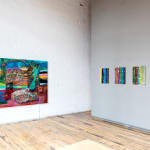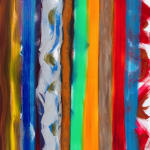Vie des Arts
The Time and Place of an Exhibition: Gina Rorai at Corkin Gallery
Light moves imperceptibly eastward in wide, motley patches across the polished concrete floor of the main space at Corkin Gallery. As the day passes through four skylight casements, it mixes with the halogens hung high in the nineteenth-century industrial ironwork and illuminates Gina Rorai's three-and-half-metre-wide painting "Infinity With the Mountain M" (2016-2019). I am alone here because this is the lockdown time of COVID-19, and the exhibition, Rorai's Where One Finishes the Other Begins, has been carefully abandoned and absent of viewers for several weeks. Perhaps, on a fantastic, imaginative level, the many exhibitions left behind in this state across the world can be conceived of as ideal compositions. Rorai's paintings, deeply immersed in the history of visual art, can speak with each other not only after gallery hours, but continuously and without the probable disrespect of our "post-culture," as George Steiner called it in In Bluebeard's Castle (1971). But the spring of 2020, a season of isolation and distance, asks for more pressing thoughts about the nature-the time and space-of exhibitions. It confirms what most of us know. An exhibition has a fundamental, unbreachable form which consists of three elements: a space, an artwork, and a viewer. The space must be real and not virtual; the viewer must, preferably, be willing and engaged; and the artwork must have enough living presence or urgency to sustain the other two aspects of the equation. When exhibitions come to us exclusively in the flattened space of a device, they are not originary but instead depend upon their viewer's actual and past experiences of exhibitions and artworks. André Malraux's Le Musée Imaginaire (1947) is the mid-twentieth century's "world of art" as conceived by a culture which deeply knew museums and exhibitions in the real. When, in Hannah Rothschild's documentary To the Studio (2001), Frank Auerbach holds a postcard in his hand of Ingres's Madame Moitessier (1851) and speaks as if the mid-nineteenth-century painting were present before him, he can do so because he is inculcated by his experience with the painting, by the flesh of his body before the material of Ingres's works in the National Gallery in London. Exhibitions establish the physical experience necessary for acts of memory, which is primarily how art lives-as the stuff of memory within our instinctual imagination. And for that matter, it is also often how art is made. If the virtual museum is capable of spiritual nourishment, it must take up-no matter what its methods of reproduction or digital resolution-the sum of its viewer's neurons activated in the memory of real time and space. Each of the three major paintings in this exhibition, To Be and To Become (2020), Where One Finishes the Other Begins (2020), and Infinity With the Mountain M, has its own wall, and hence its own daylight. These paintings, and with them their viewer's impressions, change with the light over the course of the day. This is also true of Rorai's lovely smaller works, all on one wall: Ascending #2 (2019), The Hawthorn Tree (2020) and Alcove (2020), rushes of paint that resonate with Toronto artist John Meredith's work of the early 1960s. Before you find out which paintings you most want to spend time with, you can be led by the way one painting has clearly emerged out of another in the course of the painter's labour in her studio. On foot, you begin to know this landscape. By wandering the exhibition, you step into association. The space must be real and not virtual; the viewer must, preferably, be willing and engaged; and the artwork must have enough living presence or urgency to sustain the other two aspects of the equation. There is a tree in the centre right of Infinity With the Mountain M that is mostly leafless. Like its trunk, caught up in the blues, greys, and reflected golden light of the body of water visible beyond it, its branches are tangled in the light that they reach for. Soon they are light more than tree, branches sprouting, budding with white light. Farther right and toward the foreground is a tree like a tall, tangled bunch of wild ferns and blossoms. Five apples are scattered near its base-which is not to say that they belong to the time and place of the tree, probably they do and do not belong; Rorai's time and place is multiform. One or two of the apples are quickly brushed with a line of circumference over a layered body. Three paintings are scattered here, too-a criss-crossed, red abstract panel and two landscapes. Because of their small size, each painting would not be more difficult to hold than a book. They are gently angled up, presenting themselves to the visible. Nearby is a lush presentation of flowers, and to the left of the flowers, not apparent at first and painted in line, is a big frog. This loose and complex foreground suggests, equally, a picnic, a celebration, and a ritual of remembrance. Yet, it is as if it has assembled itself, perhaps for itself, so that nature can speak of human things like memory, hope, and beauty. Rorai's colour, like scent in a garden, completely finds you only in the here and now. Because her colour is often not one but several colours becoming form as they are brushed onto the canvas, it is often unnameable. But I like to think that her palette has the living and memorial weight of the names of people and things-Rose, Violet, Lavender, Cobalt, Pine, Cerulean, and Orange. Her sky is the movement of the brush guiding movement beneath consciousness. "The poems flow from the hand unbidden and the hidden source is the watchful heart," wrote Irish poet Derek Mahon. Beyond simile-this is like that-is the territory of this is like this is like this. "What the past, the present and the future share is a substratum, a ground of timelessness," John Berger observed in his book on time and space, And our faces, my heart, brief as photos (1984). Rorai's landscapes share this ground. They speak of the absolute beauty that can be found in living, and they speak of the people one loves, now and forever. They might be memorials as envisioned by the dead for the living. Reminders to live with the utmost feeling, to see with the most encompassing sense of what might exist. You do not want to leave the richness and beauty of these paintings any more than you want to leave life, the strange dream of life, all too short. One of the characteristics of paintings and exhibitions is that because they exist fully only in real time and space, you must leave them, even if you might be lucky enough to return to some of them. You cannot fully take them with you on a mobile device, and they are not instantly retrievable at any time and place. To have them primarily in this way, via the media of our too often physically absented culture-a condition that the current pandemic has only reinforced-is never to truly see them at all.



